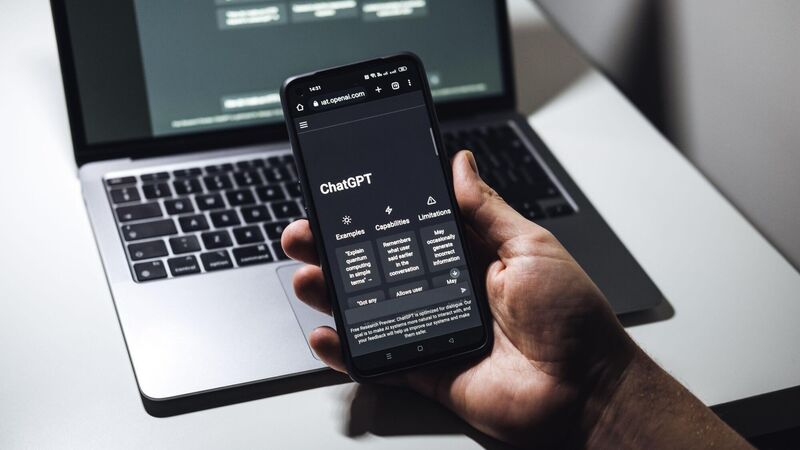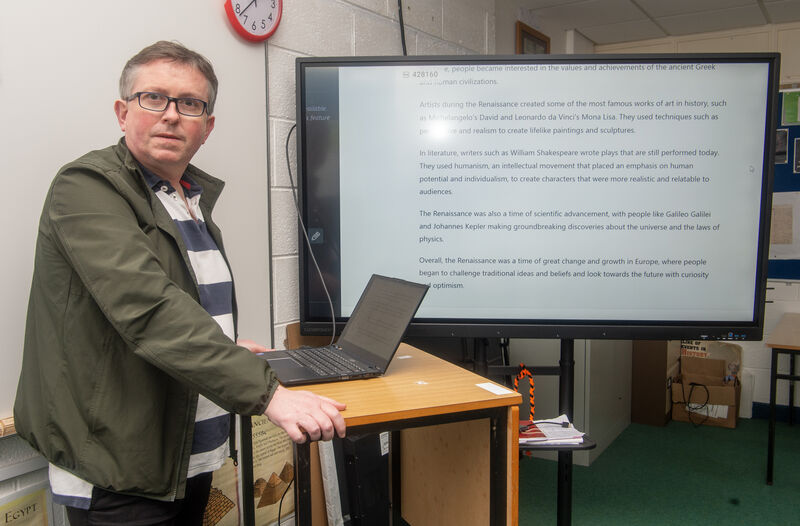How will ChatGPT and artificial intelligence be used in our classrooms?

When ChatGPT first started to gain traction, the immediate reaction of most in education was to worry about how it could be used to cheat, as it produces original text that evades traditional plagiarism detection tools. Picture: Alamy Stock
It’s not every day a spirit visits the classroom, but that is what happened when history teacher Patrick Hickey conjured up the ghost of a medieval peasant as a special guest for his first-year students.
To a spellbound class at Boherbue Comprehensive School in Mallow, the ghost told students all about his hard life on the farm, working dawn till dusk.
To top that off, he got the bubonic plague, describing to the students the pus-filled boils, fever, and chills that gripped his body before his excruciating death.
“First years love that kind of stuff, about plagues and diseases, as you can imagine,” Mr Hickey told the .
The group even had a chance to take part in a supernatural Q&A session with the ghost.
“I said to the class 'come on, we'll ask him more questions',” Mr Hickey explained.
“One person said ‘what’s his name?’ What’s his name! I said ‘Jees, I was so rude. We never asked him his name.’
News of the ghost spread quickly at lunchtime and when Mr Hickey greeted his second class of first years, they all had one question ‘when do we get to speak to the ghost?’
Lest you think they’d be using Ouija boards or dabbling in the occult in classrooms in North Cork, Mr Hickey is one of the first Irish teachers using ChatGPT to innovate in the classroom. He fed specific prompts to the AI chatbot, building on his recent lessons about the medieval period and the feudal system.
Launched in November, artificial intelligence (AI) chatbot ChatGPT has captured widespread public attention thanks to its capacity to write anything from poems, essays, novels, and speeches. It is one of the most well-known Large Language Models (LLM) currently in the public domain.
The rapid introduction of similar technology has ignited a debate on the future of work, and raised fears about its potentially existential impact on jobs and academic standards.
When ChatGPT first started to gain traction, the immediate kneejerk reaction of most in education, naturally enough, was to worry about how it could be used to cheat, as it produces original text that, by and large, is evaded by traditional plagiarism detection tools.
Universities moved to update their policies and plagiarism checker Turnitin began to develop software to identify when an AI chatbot is used to craft an essay. Here, the State body responsible for academic standards Quality and Qualifications Ireland (QQI), and the National Academic Integrity Network (NAIN) are monitoring developments.
This week, the group will host a series of webinars with international experts on the opportunities and challenges posed by artificial intelligence.
A spokesman for the Department of Further and Higher Education said it understands that a number of education and training providers have initiated reviews of their policies on assessment and academic integrity in light of the emergence of these new AI tools.
However, while the people first raising the alarm about ChatGPT were mainly teachers and professors, a recent survey from the US now indicates teachers are its number one users.
At Boherbue Comprehensive School, Patrick Hickey is what you’d call an early adopter of ChatGPT. A popular, avuncular teacher, he’s behind the @lchistorytutor handle on Instagram, Twitter, and Tiktok, where he’s no stranger to using light-hearted memes to engage with students while sharing the tips and tricks he’s picked up as a Leaving Cert history examiner with the State Examinations Commission (SEC).
He recently held a Zoom webinar for teachers about how to use the AI chatbot to revolutionize their approach to teaching and learning; 1,600 teachers attended. He believes that Ai will not replace teachers, but that teachers who use AI will replace those that don’t.
“It hasn’t taken off here just yet but if the course I gave [last week] is anything to go by, teachers know about this, and they know it’s going to snowball. It’s going to change work, it’s going to change our lives, it's going to change everything.”
The debate about introducing ChatGPT to education reminds him of the same debate that was had when calculators were introduced into schools.
“The thinking was ‘kids won’t be able to do sums in their heads anymore’. I remember when the internet was first introduced, it was the same. ‘They are going to get on to the internet, they are going to Google and copy and paste’ and the same with phones and social media were boogeymen as well. Now every school is up to its neck in devices and happy to use them,” he laughed.
Curious when he first heard of ChatGPT, he asked the bot to write him a 1,500-word essay on Malcolm X, not unlike the type of essay students are asked to complete as their Leaving Cert project.
“It churned it out. It looked short so I put it into Word; It was 800 words long. If it was a 1,500-word essay, it would struggle to get a H2.”
Where ChatGPT will help students and teachers shine is with planning and prompts, he believes.
“The thing that scares most people when writing is the blank page. This gets the ball rolling. That applies to student work, but it also applies to teachers.
“Especially now teachers who are planning lessons for the first time, trying to get great ideas, trying to differentiate, trying to have inclusive classrooms, trying to design questions. Trying to think of questions as a teacher to meet all those different kinds of things takes time.
"It takes effort, and mental energy, and we are at the pin of our collar all the time, trying to teach, trying to look after our responsibilities in schools and manage our lives outside schools as well. It’s non-stop.
“A teacher like me could use ChatGPT for lesson design ideas and then we will have more time for the things we love about teaching; Being creative, making classes that are engaging, and not being distracted all the time by ten emails that have to be answered, a report that has to be written.”

The reason why professors were so concerned originally about the introduction of technology such as ChatGPT, Mr Hickey reckons, is because they realise the traditional form of assessment, like exams, won’t cut it anymore.
“The world is changing, and educational institutions need to change as well. If we have ChatGPT in the world, rather than telling someone to go away and write a 5,000-word thesis for a business course, tell them to come up with a business plan, set up that business. That’s what college should be about, getting hands-on," he said.
“Have the theory, have the reading, that has to be done, but have them apply it. Not in an essay or in a thesis but actually by setting up that business. That’s the way education needs to go.”
The Department of Education is currently working closely with the EU Commission on emerging digital technologies such as AI. A spokesman confirmed that its the department's policy to not endorse any products, publications or services from individual providers.
"Choices regarding the use of educational materials, textbooks and other educational products as well as digital and online services, which may aid the delivery of the curriculum, are made by individual schools and their boards of management, not by the department," he said.














